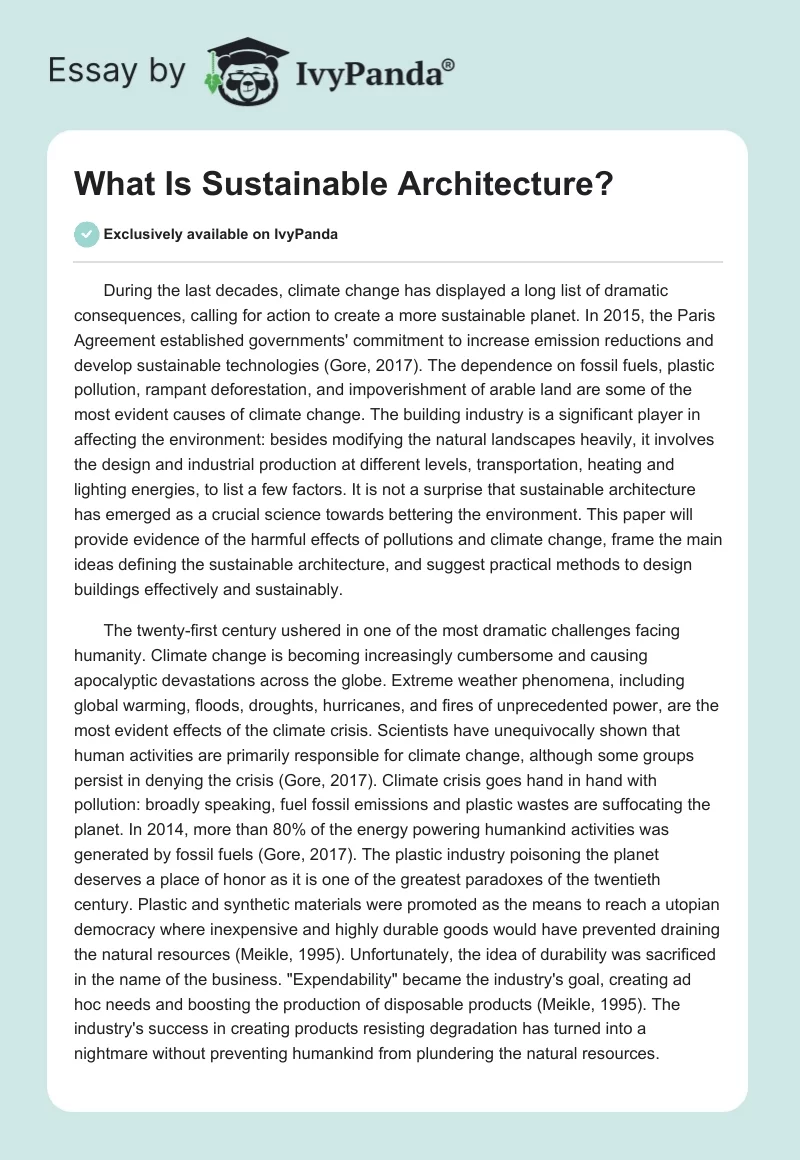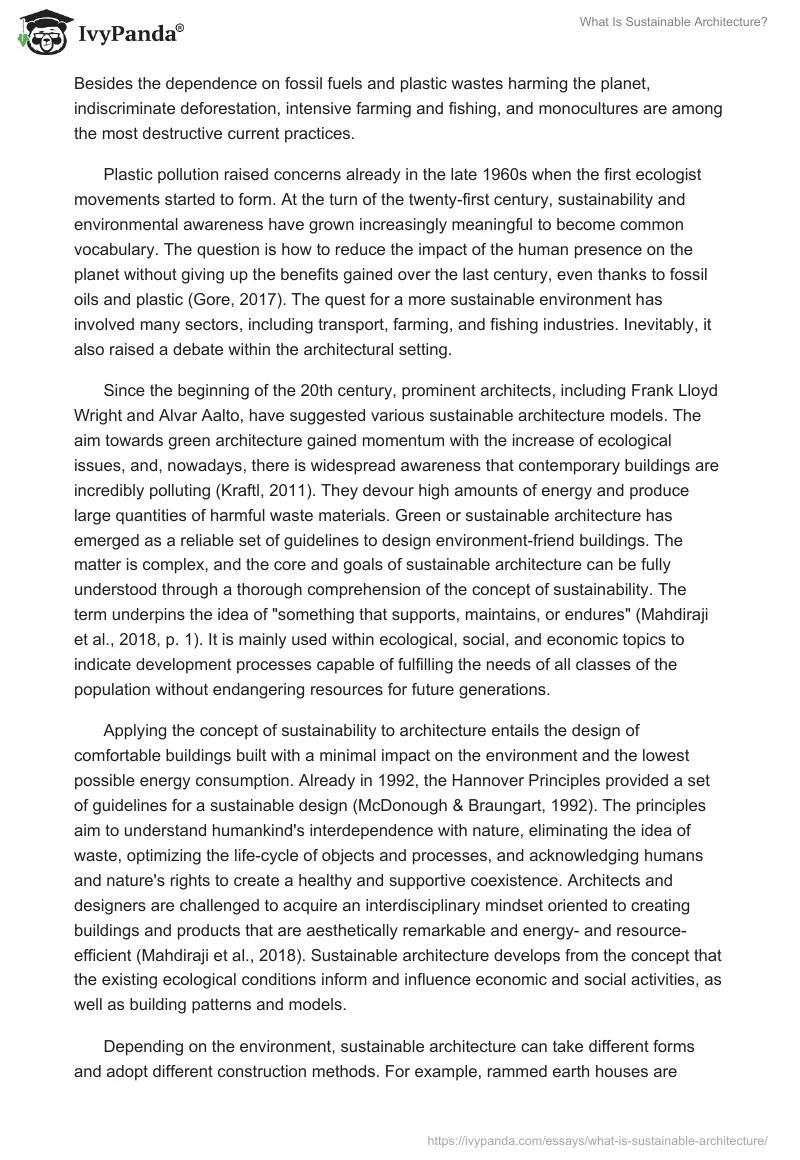During the last decades, climate change has displayed a long list of dramatic consequences, calling for action to create a more sustainable planet. In 2015, the Paris Agreement established governments’ commitment to increase emission reductions and develop sustainable technologies (Gore, 2017). The dependence on fossil fuels, plastic pollution, rampant deforestation, and impoverishment of arable land are some of the most evident causes of climate change. The building industry is a significant player in affecting the environment: besides modifying the natural landscapes heavily, it involves the design and industrial production at different levels, transportation, heating and lighting energies, to list a few factors. It is not a surprise that sustainable architecture has emerged as a crucial science towards bettering the environment. This paper will provide evidence of the harmful effects of pollutions and climate change, frame the main ideas defining the sustainable architecture, and suggest practical methods to design buildings effectively and sustainably.
The twenty-first century ushered in one of the most dramatic challenges facing humanity. Climate change is becoming increasingly cumbersome and causing apocalyptic devastations across the globe. Extreme weather phenomena, including global warming, floods, droughts, hurricanes, and fires of unprecedented power, are the most evident effects of the climate crisis. Scientists have unequivocally shown that human activities are primarily responsible for climate change, although some groups persist in denying the crisis (Gore, 2017). Climate crisis goes hand in hand with pollution: broadly speaking, fuel fossil emissions and plastic wastes are suffocating the planet. In 2014, more than 80% of the energy powering humankind activities was generated by fossil fuels (Gore, 2017). The plastic industry poisoning the planet deserves a place of honor as it is one of the greatest paradoxes of the twentieth century. Plastic and synthetic materials were promoted as the means to reach a utopian democracy where inexpensive and highly durable goods would have prevented draining the natural resources (Meikle, 1995). Unfortunately, the idea of durability was sacrificed in the name of the business. “Expendability” became the industry’s goal, creating ad hoc needs and boosting the production of disposable products (Meikle, 1995). The industry’s success in creating products resisting degradation has turned into a nightmare without preventing humankind from plundering the natural resources. Besides the dependence on fossil fuels and plastic wastes harming the planet, indiscriminate deforestation, intensive farming and fishing, and monocultures are among the most destructive current practices.
Plastic pollution raised concerns already in the late 1960s when the first ecologist movements started to form. At the turn of the twenty-first century, sustainability and environmental awareness have grown increasingly meaningful to become common vocabulary. The question is how to reduce the impact of the human presence on the planet without giving up the benefits gained over the last century, even thanks to fossil oils and plastic (Gore, 2017). The quest for a more sustainable environment has involved many sectors, including transport, farming, and fishing industries. Inevitably, it also raised a debate within the architectural setting.
Since the beginning of the 20th century, prominent architects, including Frank Lloyd Wright and Alvar Aalto, have suggested various sustainable architecture models. The aim towards green architecture gained momentum with the increase of ecological issues, and, nowadays, there is widespread awareness that contemporary buildings are incredibly polluting (Kraftl, 2011). They devour high amounts of energy and produce large quantities of harmful waste materials. Green or sustainable architecture has emerged as a reliable set of guidelines to design environment-friend buildings. The matter is complex, and the core and goals of sustainable architecture can be fully understood through a thorough comprehension of the concept of sustainability. The term underpins the idea of “something that supports, maintains, or endures” (Mahdiraji et al., 2018, p. 1). It is mainly used within ecological, social, and economic topics to indicate development processes capable of fulfilling the needs of all classes of the population without endangering resources for future generations.
Applying the concept of sustainability to architecture entails the design of comfortable buildings built with a minimal impact on the environment and the lowest possible energy consumption. Already in 1992, the Hannover Principles provided a set of guidelines for a sustainable design (McDonough & Braungart, 1992). The principles aim to understand humankind’s interdependence with nature, eliminating the idea of waste, optimizing the life-cycle of objects and processes, and acknowledging humans and nature’s rights to create a healthy and supportive coexistence. Architects and designers are challenged to acquire an interdisciplinary mindset oriented to creating buildings and products that are aesthetically remarkable and energy- and resource-efficient (Mahdiraji et al., 2018). Sustainable architecture develops from the concept that the existing ecological conditions inform and influence economic and social activities, as well as building patterns and models.
Depending on the environment, sustainable architecture can take different forms and adopt different construction methods. For example, rammed earth houses are unlikely suitable in a city context. Recently, various assessment criteria allow architects and designers to create sustainable buildings at an international, national, and regional level (Mahdiraji et al., 2018). However, some general design guidelines can be drawn to design sustainably and contribute to reducing the impacts of buildings at every latitude and environmental context. Local products made of non-toxic, no-synthetic, and possibly natural materials should be privileged (Mahdiraji et al., 2018). Passive solar energy, improved ventilation infrastructures, and recycled materials should become design pillars for every project. A valuable tool to assess a construction’s suitability in a specific environment is the Building Material Passport (Almusaed et al., 2020). Besides identifying the sustainable quality of construction, it helps create a database of local and environment-friend materials, moving the building industry towards a circular economy. While sustainable architecture is open to different approaches, it is essential to underline the importance of personal responsibility for design choices. It is a moral imperative as sustainability should be seen as an indispensable humankind’s goal to reach a holistic equilibrium between human activities and nature.
Since the second half of the twentieth century, environmental movements have contributed to raising awareness of the climate crisis. Fossil fuel combustion and plastic waste are the most evident menaces to the planet’s life and natural environment. Human activities are the major players causing climate change, and most industries have been questioned and challenged to find green solutions, including architecture. Sustainable design and environmental architecture are ground on ethical principles that recognize the need to create respectful coexistence between humans and nature. Environment-friend technologies and design guidelines inform all the modern approaches to sustainable architecture. Recycling, reusing, choosing natural and local materials, and renewable energy sources provide a common starting point towards a circular economy. The designer/architect is a central figure in shaping a sustainable world, and their design choices should be aware and responsible accordingly.
References
Almusaed, A., Almssad, A., Homod, R. Z., & Yitmen, I. (2020). Environmental profile on building material passports for hot climates. Sustainability, 12(9), 3720.
Gore, A. (2017). An inconvenient sequel: Truth to power: Your action handbook to learn the science, find your voice, and help solve the climate crisis. Rodale.
Kraftl, P. (2011). Fitting buildings: Ecological architecture, place, and ethics. In Heffernan, N. & Wragg, D. A. (Eds.) Culture, environment and ecopolitics. (pp. 226-254). Cambridge Scholars Publishing.
Mahdiraji, H. A., Arzaghi, S., Stauskis, G., & Zavadskas, E. K., (2018). A hybrid fuzzy BWM-COPRAS Method for analyzing key factors of sustainable architecture. Sustainability, 10(5), 1626;
McDonough, W., & Braungart, M. (1992). The Hannover principles: Design for sustainability. William McDonough & Partners.
Meikle, J. L. (1995). American plastic: A cultural history. Rutgers University Press.


